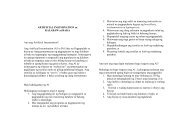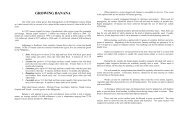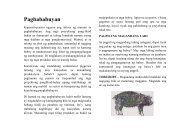HYBRID RICE PRODUCTION TECHNOLOGY - Darfu4b.da.gov.ph
HYBRID RICE PRODUCTION TECHNOLOGY - Darfu4b.da.gov.ph
HYBRID RICE PRODUCTION TECHNOLOGY - Darfu4b.da.gov.ph
Create successful ePaper yourself
Turn your PDF publications into a flip-book with our unique Google optimized e-Paper software.
<strong>HYBRID</strong> <strong>RICE</strong> <strong>PRODUCTION</strong><br />
<strong>TECHNOLOGY</strong><br />
Three hybrid rice varieties have been developed, namely: PSB Rc26H<br />
(Magat), PSB Rc72H (Mestizo), and PSB Rc76H (Panay).<br />
However, only<br />
Mestizo is currently available and recommended for nationwide planting. This variety<br />
is comparable to or better in eating quality than IR 64.<br />
______________________________________________________________<br />
_____<br />
Characteristics<br />
Variety Year Ave.Yield Max Yield Growth Height<br />
Milling<br />
Released release (t/ha) (t/ha) Duration (<strong>da</strong>ys) (cm) Recovery<br />
(%)<br />
PSB Rc72H 1997 5.4 9.9 123 97 68.7<br />
(Mestizo)<br />
1. Use new seeds every season and follow recommended seeding rate<br />
Use 20 kg new seeds per hectare. Do not use seeds harvested from<br />
previously hybrid crop.<br />
Owing to hybrid vigor, there is rapid root and greater leaf area<br />
development, leading to increased number of spikelets per unit area.<br />
This means greater yield even with only 20 kg. seeds.<br />
Soak seeds for 12-24 hours in clean water or until seeds have swelled.<br />
Change water every 6 hours if seeds are not soaked in flowing water.<br />
Then remove from water, wash the seeds, and incubate for 12-36 hours<br />
or until a white dot/protrusion (this is the root) has been observed to<br />
come out of the seeds. Keep seeds warm and moist during incubation.<br />
Note: Hybrid rice seeds may be discolored, are lighter in<br />
weight, partially filled, and slightly opened
2. Raise healthy seedlings<br />
While the seeds are being soaked, prepare land and make a 400 m 2<br />
seedbed for every 20 kg seeds to be sown. Prepare raised seedbeds 1<br />
m wide and of any convenient length.<br />
Note: Seedbed must be far from sources of light so as not to attract<br />
insects; has water supply; free from the previous crop’s disease; and<br />
can be easily drained. If drainage is a problem, raise seedbed up to 5<br />
cm.<br />
Apply 10-15 bags of organic materials (e.g. compost, carbonized<br />
rice hull, decayed chicken manure) for every 400 m 2 . seedbed to<br />
make soil loose and friable. This will facilitate pulling of seedlings<br />
and minimize root <strong>da</strong>mage.<br />
Sow the incubated seeds on the seedbed at a rate of 50 g/m 2 .<br />
(about a handful)<br />
Control weeds immediately. Weed growth is expected in plots with<br />
materials not fully decomposed and with sparsely sown seeds.<br />
Protect also the young rice seedlings from rats and golden snails.<br />
If nutrient deficiency is observed, apply ammonium <strong>ph</strong>os<strong>ph</strong>ate (16-<br />
20-0) or complete (14-14-14) fertilizer at the rate of 5-10 g/m 2 10<br />
<strong>da</strong>ys after seeding.<br />
Maintain 1-2 cm. of water. Too much water produces tall and weak<br />
seedlings.<br />
3. Prepare the land early and properly<br />
Field should be prepared 3 weeks before transplanting. Repeatedly<br />
plow and harrow the field to decompose and incorporate all weeds, rice
straw/stubbles, and animal manure. If needed, apply basal fertilizer<br />
during the last harrowing.<br />
4. Transplant seedlings then replant empty hills<br />
Transplant 21-25 <strong>da</strong>y-old seedlings at –2 seedlings/hill and at a<br />
distance of 20 cm. x 15 cm. during dry season and 20 cm. x 20 cm. during<br />
wet season.<br />
Replant empty hills not later than 3-5 <strong>da</strong>ys after transplanting to avoid<br />
uneven maturity of the crop.<br />
Note: Too close planting space results in mutual shading,<br />
less tillers, smaller panicles, and in tall and weak plants that<br />
are susceptible to lodging.<br />
5. Apply the right kind and amount of fertilizer f<br />
at the right time<br />
It is best to have your soil analyzed to know the right kind and amount<br />
of fertilizer to apply. Consult agricultural technologist in your area to<br />
know the recommended time and method of applying fertilizer.<br />
6. Maintain the right amount of water<br />
Maintain 2-3 cm. water depth 2 <strong>da</strong>ys after transplanting. Increase this<br />
to 5 cm. during late vegetative and reproductive stages.<br />
Drain water 2 weeks before harvest during wet season. During dry<br />
season, gradually drain to saturation point, preventing drying up of the<br />
soil, as this will affect grain quality.<br />
Note: Insufficient water results in wilting, thus reducing the<br />
capacity of the plant to produce and transport its food.
7. Manage the pests<br />
Insects. Practice synchronous planting-plant within a month of the<br />
regular planting time in the community. Within 40 <strong>da</strong>ys after<br />
transplanting, it is not necessary to apply insecticides against leaf<br />
feeding insects.<br />
Weeds. Apply pre-emergence herbicides 2-5 <strong>da</strong>ys after transplanting.<br />
Hand weed, if needed.<br />
Golden snails. Herd ducks in the field after harvest; handpick snails<br />
and their eggs; control water; put screen wires along water outlets.<br />
Diseases. Destroy all infected plants before the disease spreads.<br />
Practice synchronous planting.<br />
Rats. As a community, destroy all breeding sites of rats before the<br />
cropping season starts.<br />
8. Harvest on time<br />
Harvest the crop when 80% of the grains are mature. Spikelets at the<br />
panicle base are still a bit green but are already hard.<br />
Thresh immediately to minimize field losses and deterioration of grain<br />
quality.<br />
Dry palay to 14% moisture content preferably using mechanical dryer.<br />
Drying should be gradual and mixing shall be frequent for even drying.<br />
Clean seeds before storage. Ensure that the storage area is clean<br />
and well ventilated.<br />
Note: Delay in harvesting may lead to grain shattering. On the<br />
other hand, harvesting too early produces immature, chalky grains<br />
that break easily during milling.
What makes hybrid rice production different from farmers’ usual practices<br />
1. Use of 20 kg hybrid rice seeds per hectare<br />
2. Application of 10-15 bags of organic materials in a 400 m2 seedbed<br />
3. Sowing of 20 kg seeds in 400 m2 seedbed<br />
4. Transplanting of `1-2 seedlings/hill<br />
5. Use of new hybrid rice seeds every season.<br />
###<br />
Source: Hybrid Rice production Technology<br />
PhilRice, Nueva Ecija



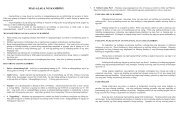
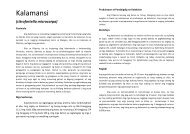
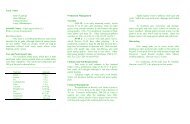
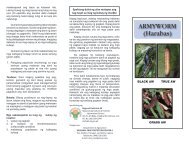
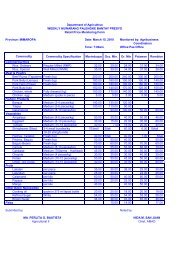
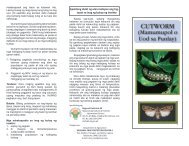
![Quick Guide-Yellow Corn Final 2-tagalog [Compatibility Mode]](https://img.yumpu.com/42848209/1/190x134/quick-guide-yellow-corn-final-2-tagalog-compatibility-mode.jpg?quality=85)


